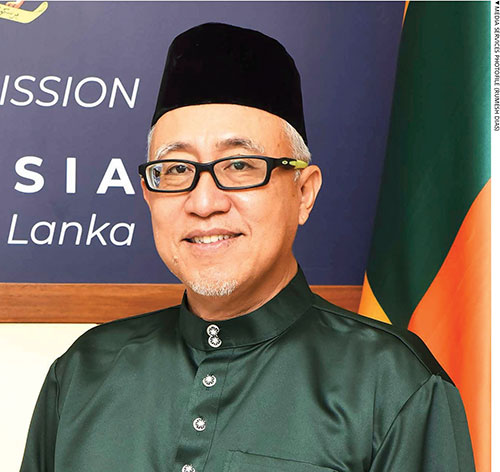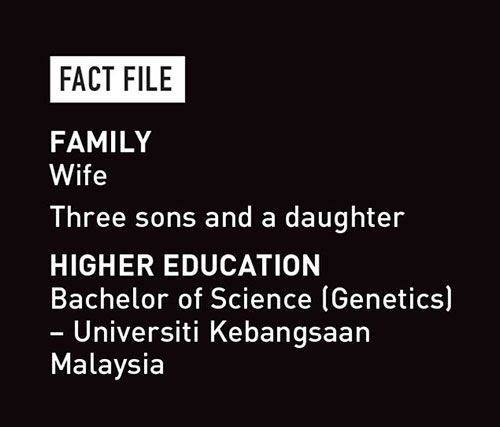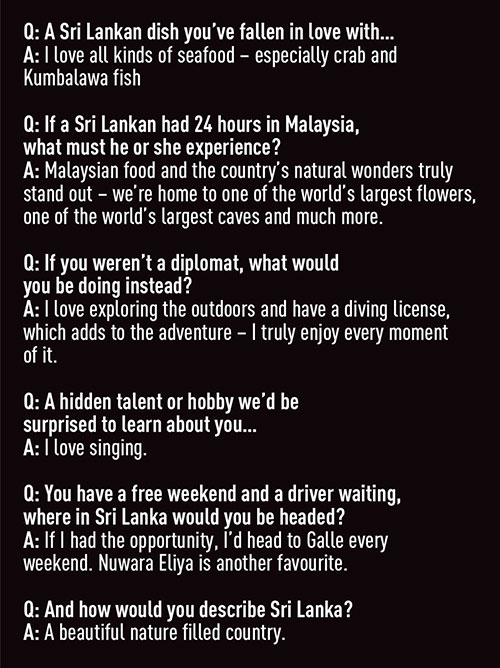LASTING TIES THAT BIND
A Free Trade Agreement would represent a milestone in strengthening bilateral economic ties, unlocking new opportunities across key sectors
High Commissioner of Malaysia to Sri Lanka
Badli Hisham Adam

Q: How would you assess the current state of diplomatic relations between Malaysia and Sri Lanka?
A: Diplomatic and people-to-people relations between the two countries have long been warm and friendly. Since establishing diplomatic ties in 1957, Malaysia has treasured its close and mutually beneficial relationship with Sri Lanka.
This year marks the 68th anniversary of diplomatic relations – a testament to the enduring and close relations between our two nations.
High-level visits and engagements have played a pivotal role in fostering mutual understanding and cooperation. Notably, the official visit by Malaysia’s Minister of Foreign Affairs to Sri Lanka in October 2023 marked an important milestone, reinforcing our commitment to enhancing bilateral ties and exploring new avenues of collaboration.
Q: What key areas or initiatives are being prioritised to further strengthen bilateral ties in the coming years?
A: Malaysia and Sri Lanka share a lot in common, in terms of global perspectives and concerns. This solid foundation sets the stage for expanding bilateral cooperation, unlocking new opportunities for growth.
Beyond trade and investment, Malaysia will prioritise key areas such as education, tourism and food security.
Initiatives to enhance technical cooperation, facilitate business-to-business linkages and promote collaboration in the halal industry are also being pursued. Both countries remain committed to revitalising ties through increased engagement and institutional dialogue.

Q: In your view, which sectors offer the greatest potential for deepening bilateral cooperation and fostering mutual growth?
A: Key sectors such as renewable energy, information technology, agriculture and education offer strong potential for deepening bilateral cooperation. Sri Lanka’s commitment to renewable energy, particularly through the Green Energy Acceleration Plan 2025-2030, presents promising opportunities for collaboration.
With its established renewable energy sector, and advanced technologies in solar, biomass, hydro and energy efficiency systems, Malaysia is well-positioned to support Sri Lanka’s green transition. Strengthening cooperation in this area not only aligns with both countries’ sustainability goals but enables joint ventures, technology transfer and capacity building initiatives.
Additionally, infrastructure development and tourism remain key growth areas. Malaysia’s expertise in Islamic finance and Sri Lanka’s interest in economic diversification present further avenues for meaningful partnership.
Q: With over 68 years of diplomatic relations between our two nations, how do you envision the trajectory of this partnership over the next five to 10 years?
A: Over the next decade, I envision a deeper, more strategic partnership between our two countries, marked by increased trade, broader cultural exchanges and enhanced people-to-people connectivity.
Our cooperation is expected to evolve beyond traditional sectors, embracing emerging areas such as climate resilience, digital transformation and youth empowerment.
And our partnership with Sri Lanka also extends to regional cooperation. As a key member of the Association of Southeast Asian Nations (ASEAN), Malaysia can serve as a strategic gateway for Sri Lanka to deepen its economic and diplomatic engagement with the region.
Malaysia’s chairmanship of ASEAN in 2025 presents a timely opportunity to elevate bilateral ties and promote more inclusive regional cooperation, recognising Sri Lanka’s potential role within the ASEAN framework.
Q: Discussions on a potential FTA with Malaysia are underway as part of an economic recovery strategy. Which sectors do you foresee benefiting the most from such an agreement?
A: A Free Trade Agreement would represent a milestone in strengthening bilateral economic ties, unlocking new opportunities across key sectors such as technical cooperation, processed food, the digital economy, and services including logistics and education.
It could also promote a more balanced and diversified trade relationship, by increasing market access, boosting competitiveness and fostering sustainable economic growth for both countries.
Q: What strategies are being explored to enhance people-to-people connectivity between the two countries?
A: Malaysia has long been a preferred destination for Sri Lankan travellers, offering cultural diversity, modern attractions and strong bilateral ties. Over the years, Sri Lankan arrivals to Malaysia have grown steadily with over 58,000 tourists visiting last year – an impressive 122 percent increase from pre-pandemic levels in 2019.
Moreover, Sri Lanka’s introduction of visa free entry for Malaysian tourists in late 2023 contributed to the rise in arrivals from our country. The growing number of visitors travelling between our nations reflects a deepening interest, and strong potential for further collaboration in tourism and cultural exchange.
To enhance people-to-people connectivity between the two countries, several strategies are being pursued. These include promoting tourism campaigns such as Visit Malaysia Year 2026, expanding direct flight connectivity, and encouraging joint cultural and academic programmes.
Strengthening these bonds is essential to fostering mutual understanding, deepening ties, and building long-term goodwill between Malaysia and Sri Lanka.


